American Catholic History
Telling the stories of Catholics on these American shores from 1513 to today. We Catholics have such an incredible history in what are now the 50 states of the United States of America, and we hardly know it. From the canonized saints through the hundred-plus blesseds, venerables, and servants of God, to the hundreds more whose lives were sho-through with love of God, our country is covered from sea to shining sea with holy sites, historic structures, and the graves of great men and women of faith. We tell the stories that make them human, and so inspiring.
Episodes
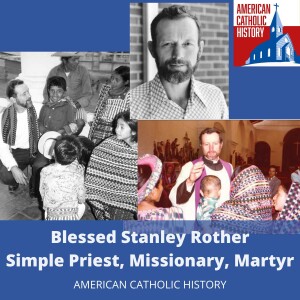
4 days ago
4 days ago
Stanley Rother was born in Okarchee, Oklahoma the oldest of four children to a family of Catholic German farmers. He grew up learning the ways of farming, playing sports, and serving Mass. He entered seminary but struggled with some theology classes and Latin. The seminary eventually sent him home saying he wasn't priest material. Fortunately his bishop and Mount St. Mary's Seminary in Emmitsburg, Maryland wanted to give him another chance. He graduated and was ordained a priest for Oklahoma City-Tulsa in 1963. In 1968 he requested to be a missionary in Santiago Atitlan, Guatemala where the Diocese had a mission. He went and learned both Spanish and the difficult Tzutujil language of the small community of native peasants among whom he served as a missionary. He poured himself into the work, eventually translating the Mass and even the New Testament into Tzutujil. He also worked to bring modern farming techniques to the community and taught math along with language and catechetical lessons. His efforts, however, made him a target of both the government and left-wing militant groups who were fighting a bloody civil war that lasted decades. A number of his parishioners were victims of the Civil War as they refused to cooperate with either side of the fight. Father Rother wrote that "the shepherd doesn't flee at the first sign of danger." Eventually he was found to be number 8 on a death list, so his bishop ordered him to return to Oklahoma. He spent a few months at his family farm, but eventually requested permission to return to Santiago Atitlan to be with his people for Easter. He returned in April 1981, but on July 28, 1981 he was gunned down in the rectory in the middle of the night. He was regarded as a martyr and a great man from immediately after his death. His body was returned to Oklahoma, but his heart was returned to Santiago Atitlan where it remains. His cause for canonization opened in 2010, and he was beatified in a large outdoor Mass in Oklahoma City in 2017. A large shrine dedicated to Blessed Stanley Rother opened in 2023 in Oklahoma City.
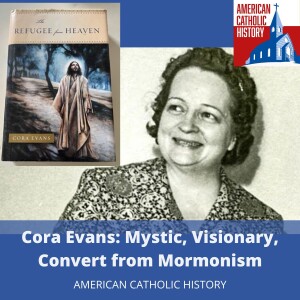
Thursday Jul 10, 2025
Thursday Jul 10, 2025
Cora Evans grew up a good Mormon, but had a crisis of faith during her wedding at the Mormon Temple in Salt Lake City. She and her husband left the Mormon faith, and eventually became Catholic. This led to hardships as they were shunned for their apostasy. They had to flee Utah for California where they lived the rest of their lives. Cora's conversion came about in part because she had been having visions of the Blessed Mother since she was very young, but it wasn't until she spoke with a Catholic priest when she was 30 that she realized who this "beautiful lady" who visited her was. Her mystical experience grew in intensity, and eventually included many visits by Jesus himself, whom she alwasy called "The Master." Jesus gave her the mission of spreading devotion to the "Mystical Humanity of Christ," and he charged her to write and document her experiences. She had never written much, and wasn't highly educated, but she was obedient and she wrote about what Christ revealed to her. Her experiences came to the attention of the Church in Los Angeles, and the archbishop had Jesuits and other priests visit her to test the authenticity of her visions. Her responses and understanding convinced the experts and the archbishop that her visions were genuine, but that they were private revelations, not to be publicized at least during her lifetime. Eventually her writings filled boxes and boxes worth of manuscripts about her experiences. Some have been published, including one published under the title Refugee from Heaven. Those who carry on her work still offer conferences and retreats to help people live a life according to the Mystical Humanity of Christ. In 2010 her cause for canonization was officially opened, giving her the title of Servant of God.

Monday Jul 07, 2025
Monday Jul 07, 2025
Franciscan Fr. Juan de Padilla accompanied Coronado on his 1541 mission into New Mexico to search for the legendary Seven Cities of Gold. Father Padilla was looking for souls to evangelize and save. After Coronado’s search was frustrated, Fr. de Padilla remained behind to evangelize natives among the Ouichita — or Wichita — in modern day Kansas. Details aren't clear as to how or precisely where, but for his efforts he was the first to shed his blood for Christ in the New World. Three different markers in modern day Kansas mark places where his martyrdom could have happened. All three are within 100 miles of the geographic centerpoint of the contiguous 48 states. His martyrdom happened about 100 years prior to the first of the North American Martyrs in New York.
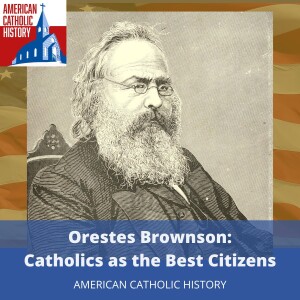
Monday Jun 30, 2025
Monday Jun 30, 2025
Orestes Brownson was the first major American Catholic intellectual to gain an international reputation. His thinking on the significance of America, and the place of Catholics within American political life was new and unexpected. He believed, contra what many anti-Catholics in his day believed, that not only could Catholics be good Americans, but that Catholics could be the best Americans. He also had strong opinions on slavery. Brownson opposed slavery as a great evil, but he was not an abolitionist. He believed that those who held slaves had a moral obligation to treat them well, and to prepare them to be free men and women, but that simply freeing all slaves would bring about great harm to the slaves as well as society. But once the Civil War began, he became an abolitionist, believing that, since the South made the war about the right to own slaves, slavery must be ended as part of the North’s victory in the Civil War.
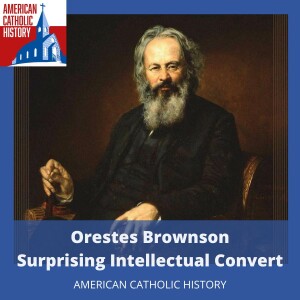
Friday Jun 27, 2025
Friday Jun 27, 2025
Orestes Brownson was a major intellectual of the 19th century, and a Catholic convert in his 41st year. Born in 1803 in Vermont, he was raised Christian, but in no particular Christian denomination or sect. He was largely self-taught, and had a strong sense that one must follow reason to arrive at truth, no matter where it was found. In his teens he began a struggle for religious truth that would start in Presbyterianism, then through Universalism, and Unitarian Transcendentalism, before he finally became Catholic, and remained so for the remaining three decades of his life. This is part one of a rare two-part treatment of a topic.

Monday Jun 23, 2025
Monday Jun 23, 2025
Noel Dubé, Noëlle’s grandfather, was a hero of World War II, landing on D-Day and playing a key role in the breakout from the beaches and the race through the hedgerows of Normandy. He also raised ten children with his wife Toni and started a local shrine to Our Lady which drew thousands of visitors annually from across the country. His devotion to Mary began at a young age when his mother died and he took Mary to be his mother.

Thursday Jun 19, 2025
Thursday Jun 19, 2025
John Wayne, the icon of American manliness and one of the most important film stars of all time, once called himself a "cardiac Catholic." He meant that he intended to become Catholic on his deathbed. Born Marion Morrison he was raised a Presbyterian, but all three of his wives were Catholic. We're not sure how that worked out, since none of them predeceased him, but we leave that to God's grace and the wisdom of the Church. However, the example of many Catholics in his life, particularly his first wife, had a deep impression on him. Despite serious problems with infidelity, John Wayne did manage to become Catholic and make his amends with God before his death.
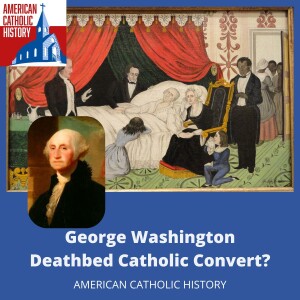
Monday Jun 16, 2025
Monday Jun 16, 2025
Since shortly after he died in 1799, questions have circulated about whether George Washington converted to Catholicism on his deathbed. The evidence isn't conclusive in either direction, but a number of factors point to this possibility. Chief among them is that Washington requested that a Catholic priest come to his bedside as he lay dying. One of the Neale brothers who was a Jesuit priest in Piscataway, Maryland, right across the Potomac from Mount Vernon, attended Washington and was with him for nearly four hours. If Washington became a Catholic convert many would not be surprised, as he had displayed an affinity for Catholics and for the Catholic Church for most of his adult life. In this episode we consider all of the evidence for the potential deathbed conversion of the Father of America.
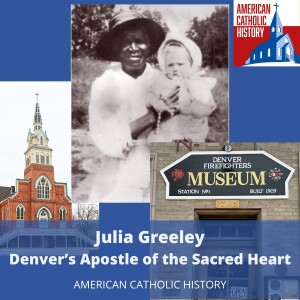
Thursday Jun 12, 2025
Thursday Jun 12, 2025
Julia Greeley was born a slave in Missouri. After Missouri abolished slavery she moved to Denver, Colorado where she worked for the family of the first governor of Colorado. She became Catholic in 1880 and developed a deep devotion to the Sacred Heart of Jesus. She devoted her life to helping anyone who needed assistance. She would give to others from her own meager earnings, any anything she couldn't afford she would beg for. She was a daily communicant and a prayer warrior. At least one couple overcame infertility through her prayers. She loved children and would organize days in the park for children who didn't have the opportunity. One special ministry was to firefighters. She would go around every First Friday — the day of devotion to the Sacred Heart — and bring pamphlets about the Sacred Heart devotion to all of the firehouses in Denver. She died on the feast of the Sacred Heart in 1918. She did so much good for so many that her funeral was massive. Her cause for canonization opened in 2016, when her body was exhumed and reinterred in the Cathedral Basilica of the Immaculate Conception in Denver. She is the only person buried in that church, which opened in 1912.
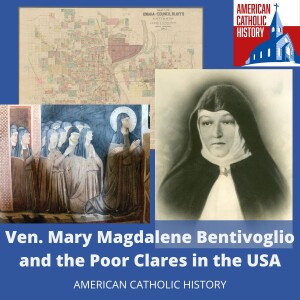
Wednesday Apr 30, 2025
Wednesday Apr 30, 2025
Mother Mary Magdalene Bentivoglio was born Anna Bentivoglio into Italian and French nobility in the mid 1800s. But both of her parents died before her 27th birthday. Since she and two of her sisters were still single, Pope Pius IX took responsibility for them and they were placed in a Benedictine abbey. This experienced compelled all three to desire religious life, but a more austere experience of it. So they became Poor Clares of the Primitive Observance. Ten years after taking their final vows two of them, Mary Magdalene and one of her sisters who had been given the religious name Constanza, were selected by Pius IX to go to the United States to help a third order Franciscan community establish a school. This fell apart shortly after they arrived in the US, and they found themselves stuck in New York City with no money, no plan, and no English. They appealed to the archbishop of New York to establish a Poor Clare monastery in his archdiocese, but he refused. They appealed to other dioceses, but got many rejections until the archbishop of New Orleans welcomed them. But then they were forced to move to Cleveland. Another setback prompted them to go searching for a home again, until John Creighton, the Omaha industrialist and philanthropist, learned of their plight and pledged to build them a monastery in Omaha. Things began looking up, but there were still other trials awaiting them. But through it all, Mother Mary Magdalene brought her stubbornness, and her absolute trust in God's providence, to bear on all hardships and opportunities. She died in the early 1900s. More than 20 Poor Clare monasteries in the United States and Canada trace their roots to the trailblazing faith, zeal, and dedication of Mother Mary Magdalene Bentivoglio. Her cause for canonization was opened in 1929, and when her body was exhumed she was found to be incorrupt. In 1969 she was declared Venerable.










